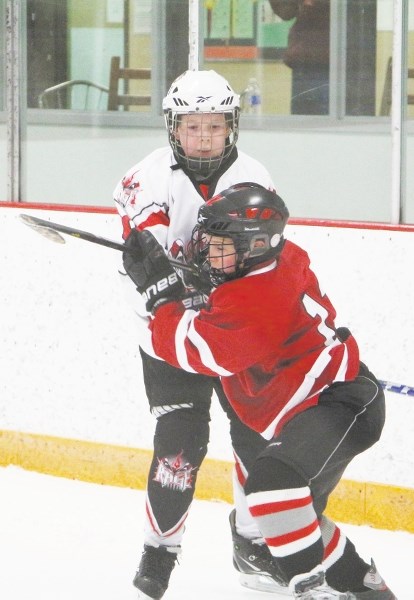Now that Hockey Alberta has blown the whistle on intentional body-checking in Peewee hockey, Cochrane Minor Hockey (CMHA) is re-tooling its Peewee programs to meet the provinces’s new criteria for contact.
The May 8 decree removing intentional body contact will, according to Hockey Alberta, eliminate 400 concussions and 1,000 injuries per season for 11- and 12-year-old hockey players.
“We support it, we’ll follow it,” said CMHA president Howie Kroon. “The part that we haven’t figured out yet is how we’re going to transition kids from Atom into Peewee and Peewee into Bantam without any hitting. From a ‘How do we prepare kids for that transition to Bantam now?’ “I don’t think our mindset has been there. Obviously, there’s a little bit of work to be done in terms of figuring that out.”
Instead of learning how to body-check at age 11, players will now wait until they’re 13 to learn one of our national winter pastime’s fundamental skills. Kroon mentioned that, until now, players graduating from Atom to Peewee would take part in a body-checking skills clinic prior to joining the Peewee ranks. That process has now been delayed to the Bantam level for kids aged 13-14.
“When someone goes from Atom to Peewee, they have to take a hitting clinic,” Kroon related. “The extent of that hitting clinic may have to be modified or enhanced (for Peewees graduating to Bantam).”
Dennis Beaudoin, Central Alberta Hockey League (CAHL) vice-president in charge of Peewee and Novice divisions, presides over seven different Peewee divisions with 63 teams totalling more than 1,000 players. All, until now, involved full-contact hockey. But he assures the game won’t change as drastically as some fear.
“It just removes the checking out of it,” Beaudoin observed. “It doesn’t removed the body contact - skating through the hands, incidental contact; that kind of stuff will still be allowed.”
Anyone who’s watched high-level Peewee hockey this past season understands the pace and intensity of play mirrors that of the game played at much higher levels. These 11- and 12-year-olds play like the big boys, right down to game plans that include dump-and-chase, and cycling the puck along the end boards with plenty of intentional contact.
Coaching strategies may change to take advantage of the new rule.
“You’re going to have to carry it in a little more often than having to dump-and-chase and hammer that defenceman,” Beaudoin said. “Hopefully we can protect those kids a little more.”
And that’s where Hockey Alberta’s no-intentional-contact edict takes aim; protecting young players from grievous injury.
“The biggest thing Hockey Alberta is trying to do is just eliminate those hits where kids are getting hammered and getting hurt,” he assured. “We’ve been watching the NHL (National Hockey League) for the last little while now, and I’ve never seen so many people losing teeth this year alone.”
When asked if this no-body-checking decision will make Peewee hockey safer, Beaudoin answered: “Absolutely. Absolutely.”
CMHA president Kroon was equally clear: “We support the decision and we will follow it.”
The CMHA holds its annual general meeting May 29 at the Spray Lake Sawmills Family Sports Centre.




